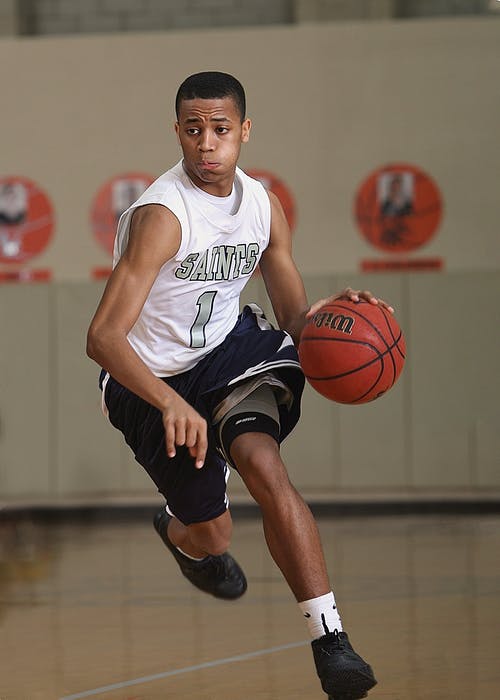Basketball is an interesting sport to develop strength and conditioning programs for. I’ve coached it from both sides as a basketball coach and as a strength and conditioning coach. Morrison et al did a great literature review looking at the sport, what types of assessments are used at different levels, and providing data on those assessments.
The authors divide their review into several sections. They begin with a short review of the sport, anthropometrics, muscular power, linear sprint speed, change of direction/agility, strength, and anaerobic capacity.
To begin with reviewing the sport and its needs, the authors point out that in basketball the players cover 400-7500 meters in a game. Each game consists of jogging, sprinting, jumping, and changes in direction. Basketball players frequently reaching speeds greater than 7 meters per second. Athletes will perform 42 to 56 jumps/game along with frequent shuffling movements. With this in mind, the purpose of this review was to identify tests used to assess basketball players, report “fitness” variables by position/level, and recommend testing approaches.
When looking at the literature, the authors divided studies into looking at the following classifications of athletes:
- Amateur (club, volunteer, recreation)
- Collegiate
- Representative (selected to play in a representative team)
- Semi pro (contract/full time)
- Professional (highest division in the country, contracted to play full time)
WHY IS IT IMPORTANT
Anthropometrics:
Understanding the anthropometrics is important because it can help us to determine what positions players are potentially built to meet the needs of. Based on the authors’ review, professional and collegiate players are taller than other levels of classification. When it comes to height, weight, and wingspan the centers are larger, followed by forwards, followed by guards. Body fat was similar across positions.
Muscular Power:
Power is important because this involves jumping, throwing, and moving explosively. The authors found that the counter-movement jump and the squat jump were two of the most common muscular power tests, though other jump tests were used in the literature. They found that jump height was similar across positions, however when it comes to jump power the centers were greater, followed by forwards, followed by guards. This should make sense as the centers, then the forwards, have to move more mass than the guards. These two tests are both great tests to be done with large groups of athletes and do not require a great deal of special equipment.
Linear sprint speed:
Basketball players do not run a hundred meters in a straight line. They sprint for short distances, stop, then move in a different direction. With this in mind, the most common linear sprint speed tests in the literature are the 5 meter, 10 meter, and 20 meter sprints. Again, these are tests that can be done with teams in a field situation. There is no data about position groups. I would expect the guards to be faster, followed by forwards, followed by centers.
Change-of-direction speed:
As I covered before, basketball players do not run in a straight line for a hundred meters. Being able to change direction is extremely important for a basketball player. In the author’s review, the T-test was the most frequent assessment. There was not a lot of data in terms of comparing position groups or comparing different levels of classification. The t-test is another easy test to run with teams in the field.
Strength:
Strength is important for basketball players because it is important for speed, change of direction, power, and for the fact that basketball is a contact sport. The most common strength tests are the back squat 1-RM and bench press 1-RM. The authors note that some tests do a 3-RM instead of the 1-RM. Professional players squatted more than collegiate players. There was no breakdown by position.
Anaerobic capacity:
Anaerobic capacity is where basketball players compete. There are lots of starts and stops in the sport, as a result this is critical. In the literature the Wingate, repeated sprint, and full court shuttle run were the most common tests. With regards to WAnT; forwards and guards were similar, centers had less power. Both the repeated sprints and the full court shuttle run are easy to do with teams in the field.
This article can be downloaded for free at Sport Medicine’s website. It has a lot of great data on the assessments that are found in the literature across various levels of classification. This can be useful as a benchmark, to help gauge where layers are, or to help place players.
Morrison, M., Martin, D.T., Talpey, S., Scanlan, A.T., Delaney, J., Halson, S.L., and J. Weakley. A systematic review on fitness testing in adult male basketball players: Tests adopted, characteristics reported and recommendations for practice. Sports Medicine, 52: 1491-1532, 2022.



